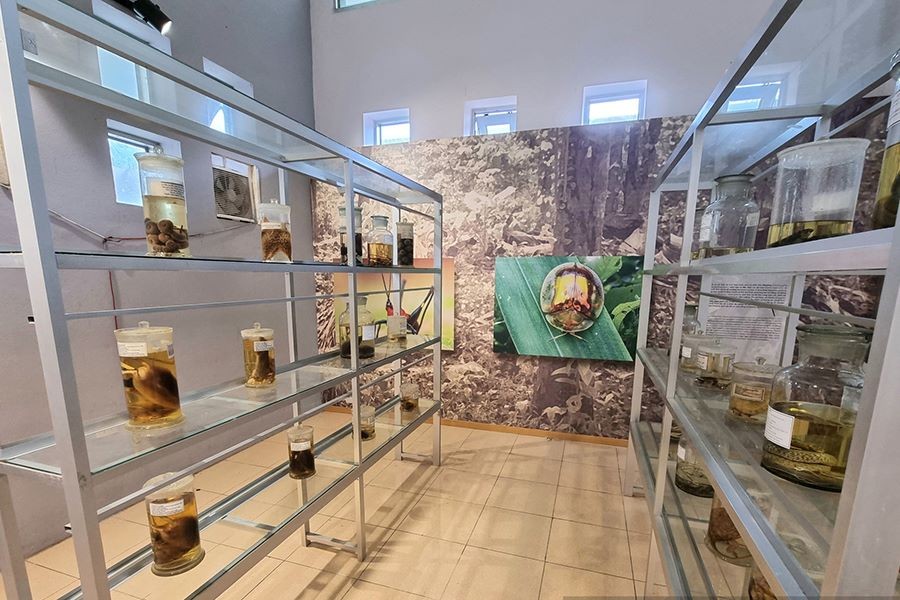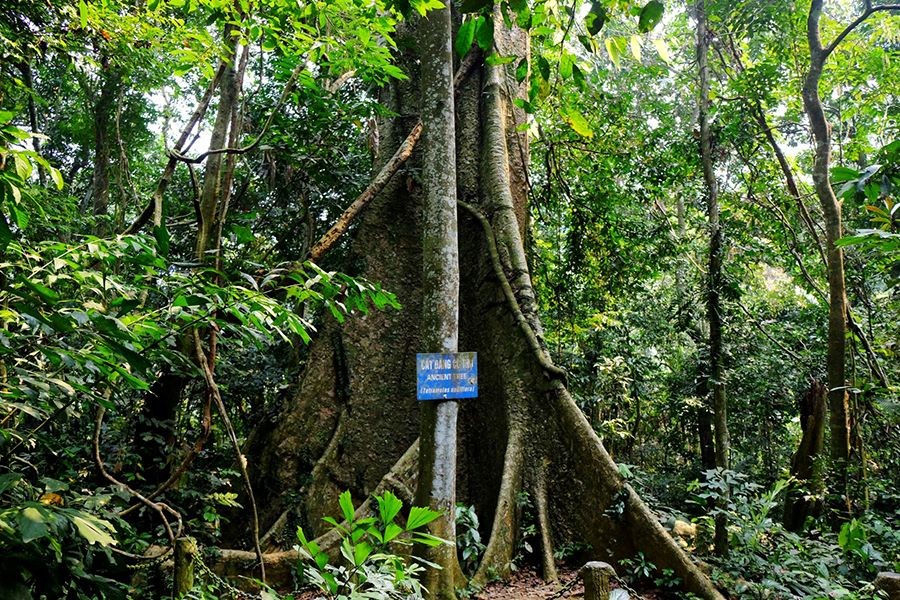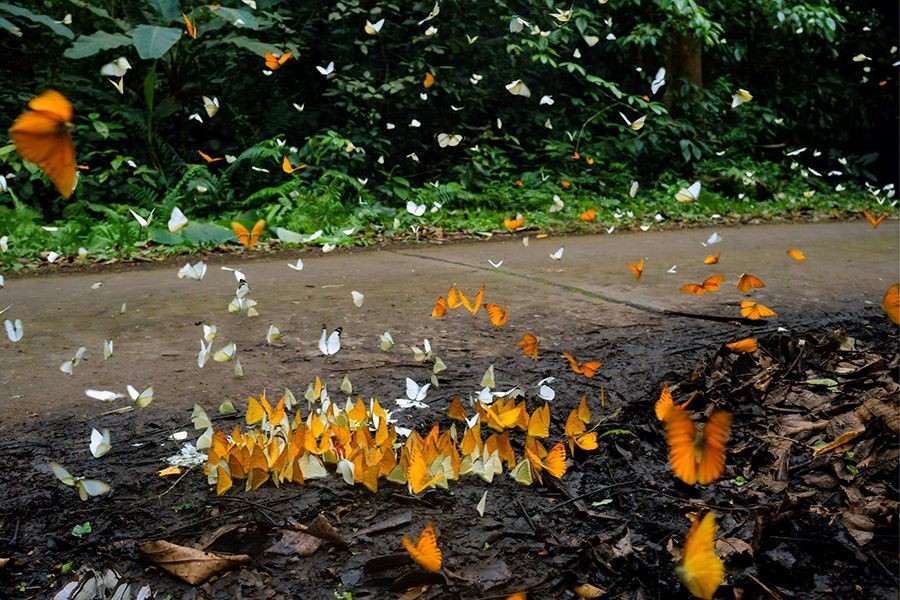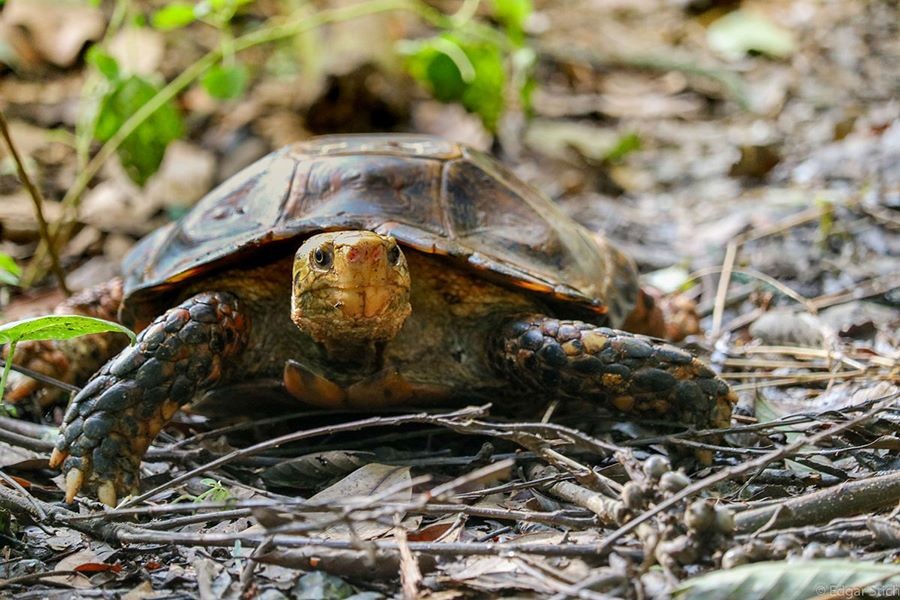Are you curious about the amazing wildlife thriving in Vietnam’s oldest national park? Discover the diverse species of primates, birds, butterflies, and reptiles that call Cuc Phuong National Park home with SIXT.VN. Let’s explore the vibrant ecosystems and creatures waiting to be discovered in this natural haven, offering unforgettable wildlife encounters.
1. What Makes Cuc Phuong National Park a Wildlife Hotspot?
Cuc Phuong National Park, established in 1962, is Vietnam’s oldest and one of its most important protected areas, renowned for its exceptional biodiversity. The park spans over 22,000 hectares across three provinces: Ninh Binh, Hoa Binh, and Thanh Hoa. Its diverse habitats, ranging from lush tropical rainforests to limestone karst mountains, support an incredible array of flora and fauna, making it a haven for wildlife enthusiasts. According to the Cuc Phuong National Park Management Board, the park is home to thousands of plant and animal species, many of which are rare or endangered.
1.1. Geographical Diversity and Climate
The park’s unique geography plays a vital role in its biodiversity. The rugged terrain and varied elevations create microclimates that support different plant communities, which in turn provide habitats for a wide range of animals. The tropical monsoon climate, with distinct wet and dry seasons, further contributes to the ecological richness of the park. The dry season, from December to May, is the ideal time to visit, as the weather is more favorable for trekking and wildlife spotting.
1.2. Conservation Efforts
Cuc Phuong National Park has been at the forefront of conservation efforts in Vietnam. The park’s management, in collaboration with international organizations, has implemented various programs to protect endangered species, restore habitats, and promote sustainable tourism. The Endangered Primate Rescue Center (EPRC) and the Turtle Conservation Center are prime examples of these initiatives, contributing significantly to the preservation of Vietnam’s unique wildlife.
1.3. Accessibility and Tourism
Despite its remote location, Cuc Phuong National Park is relatively accessible from Hanoi, making it a popular destination for both domestic and international tourists. The park offers a range of activities, including trekking, bird watching, and wildlife viewing, providing opportunities for visitors to experience the natural beauty and biodiversity of Vietnam. SIXT.VN offers convenient transportation options and tour packages to help you explore this incredible destination.
2. What Primates Can You Find in Cuc Phuong National Park?
Cuc Phuong National Park is a sanctuary for several species of primates, many of which are endangered. The park’s primate population is a key focus of conservation efforts, with the Endangered Primate Rescue Center (EPRC) playing a crucial role in their protection and rehabilitation. According to the EPRC, the park is home to over 15 primate species, making it one of the most important primate conservation areas in Southeast Asia.
2.1. Delacour’s Langur
One of the most iconic primates in Cuc Phuong is the Delacour’s Langur (Trachypithecus delacouri). This critically endangered species is endemic to Vietnam, meaning it is found nowhere else in the world. Delacour’s Langurs are known for their striking appearance, with black bodies, white faces, and long tails. They are primarily arboreal, spending most of their time in the forest canopy, feeding on leaves, fruits, and seeds.
 Delacour's Langur in Cuc Phuong National Park, showcasing its distinctive black body and white face, a critically endangered primate endemic to Vietnam
Delacour's Langur in Cuc Phuong National Park, showcasing its distinctive black body and white face, a critically endangered primate endemic to Vietnam
2.2. White-handed Gibbon
The White-handed Gibbon (Hylobates lar) is another fascinating primate found in Cuc Phuong National Park. These agile creatures are known for their acrobatic movements through the trees, using their long arms to swing from branch to branch. White-handed Gibbons are primarily frugivorous, feeding on fruits, but they also consume leaves, insects, and small animals. Their distinctive calls can be heard throughout the forest, especially in the early morning.
2.3. Hatinh Langur
The Hatinh Langur (Trachypithecus hatinhensis), also known as the Francois’ Langur, is a striking primate characterized by its black coat and distinctive white cheek stripes. Preferring the limestone forests of central Vietnam, including Cuc Phuong, these langurs are adept climbers, spending their days foraging for leaves, fruits, and seeds high in the canopy. Their conservation is critical due to habitat loss and hunting pressures, making Cuc Phuong National Park a vital sanctuary for their survival.
2.4. Other Primate Species
In addition to these flagship species, Cuc Phuong National Park is also home to several other primates, including the Assamese Macaque (Macaca assamensis) and the Rhesus Macaque (Macaca mulatta). These macaques are more adaptable than langurs and gibbons, often venturing closer to human settlements in search of food. However, they are also facing threats from habitat loss and hunting.
3. What Bird Species Inhabit Cuc Phuong National Park?
Cuc Phuong National Park is a paradise for birdwatchers, boasting an impressive diversity of avian species. According to BirdLife International, the park is recognized as an Important Bird Area (IBA), supporting over 336 bird species, including several globally threatened ones. The park’s varied habitats, ranging from lowland forests to montane peaks, provide ideal conditions for a wide range of birds, making it a must-visit destination for ornithologists and nature enthusiasts.
3.1. Key Bird Species
Cuc Phuong National Park is home to a variety of rare and endangered bird species, making it a crucial site for avian conservation. Some of the key bird species found in the park include:
3.1.1. White-tailed Robin
The White-tailed Robin (Myiomela leucura) is a striking bird known for its melodious song and distinctive white tail feathers. It inhabits the dense undergrowth of the forest, making it a challenging but rewarding species to spot.
3.1.2. Bar-backed Partridge
The Bar-backed Partridge (Arborophila cambodiana) is a ground-dwelling bird that prefers the dense forests of Cuc Phuong. Known for its shy nature, spotting one requires patience and a keen eye. These partridges play an important role in the forest ecosystem by dispersing seeds and controlling insect populations.
3.1.3. Silver Pheasant
The Silver Pheasant (Lophura nycthemera) is a majestic bird with striking plumage. The male has a long, silvery-white tail, while the female is a more cryptic brown color. They are often seen foraging on the forest floor, searching for insects, seeds, and fruits.
3.1.4. Red-vented Barbet
The Red-vented Barbet (Psilopogon lagrandieri) is a vibrant bird with a distinctive red patch on its vent. It is commonly found in the canopy of the forest, feeding on fruits and insects. Their calls are a common sound in Cuc Phuong, adding to the park’s rich soundscape.
3.2. Best Time for Bird Watching
The best time for bird watching in Cuc Phuong National Park is during the dry season, from January to April. During this time, the weather is more favorable, and many bird species are actively breeding, making them easier to spot. It is also advisable to hire a local guide who is familiar with the park’s birdlife and can help you locate the best birding spots.
 Map of Cuc Phuong National Park, highlighting trails and key areas for bird watching and wildlife observation, offering visitors a guide to explore the diverse habitats within the park
Map of Cuc Phuong National Park, highlighting trails and key areas for bird watching and wildlife observation, offering visitors a guide to explore the diverse habitats within the park
3.3. Bird Watching Tours with SIXT.VN
SIXT.VN offers specialized bird watching tours in Cuc Phuong National Park, led by experienced guides who can help you identify and appreciate the park’s diverse birdlife. These tours are designed to cater to both novice and experienced birdwatchers, providing opportunities to see rare and endemic species in their natural habitat. Let SIXT.VN enhance your bird watching experience with convenient transportation and expert guidance.
4. What Butterfly Species Can Be Observed in Cuc Phuong National Park?
Cuc Phuong National Park is renowned for its stunning butterfly diversity, with over 400 species recorded within its boundaries. The park’s lush vegetation and varied habitats provide ideal conditions for butterflies to thrive, creating a kaleidoscope of colors during the butterfly season. According to a study by the Vietnam National Museum of Nature, Cuc Phuong is one of the most important butterfly hotspots in Southeast Asia.
4.1. Butterfly Season
The peak butterfly season in Cuc Phuong National Park is from late April to early May. During this time, millions of butterflies emerge, transforming the forest into a magical wonderland. The butterflies congregate around streams and puddles, creating a breathtaking spectacle for visitors.
4.2. Notable Butterfly Species
Cuc Phuong National Park is home to a wide variety of butterfly species, each with its unique beauty and ecological role. Some of the notable butterfly species found in the park include:
4.2.1. Common Birdwing
The Common Birdwing (Troides helena) is one of the largest and most striking butterflies in Cuc Phuong. With its bright yellow and black wings, it is a sight to behold as it flits through the forest canopy.
4.2.2. Fivebar Swordtail
The Fivebar Swordtail (Graphium antiphates) is a graceful butterfly with long, sword-like tails. Its black and white wings are adorned with delicate patterns, making it a favorite among butterfly enthusiasts.
4.2.3. Great Mormon
The Great Mormon (Papilio memnon) is a polymorphic butterfly, meaning it exhibits different forms and colors. This species is known for its mimicry, with some forms resembling poisonous butterflies to deter predators.
4.2.4. Cruiser Butterfly
The Cruiser (Vindula erota) is known for its rapid flight and vibrant orange wings, often seen darting through the forest undergrowth. They are attracted to the sap of trees and decaying fruit, playing a part in nutrient recycling in the forest ecosystem. Spotting them requires patience and a quick eye, adding a thrilling dimension to butterfly watching in Cuc Phuong.
4.3. Tips for Butterfly Watching
To maximize your butterfly watching experience in Cuc Phuong National Park, consider the following tips:
- Visit during the butterfly season: Late April to early May is the best time to see butterflies in large numbers.
- Wear bright clothing: Butterflies are attracted to bright colors, so wearing colorful clothing can help you attract them.
- Bring binoculars: Binoculars can help you get a closer look at the butterflies.
- Be patient: Butterflies are often shy and may take some time to appear.
 Image of butterflies in Cuc Phuong National Park, showcasing the variety and abundance of butterfly species, making it a prime destination for butterfly enthusiasts and nature lovers
Image of butterflies in Cuc Phuong National Park, showcasing the variety and abundance of butterfly species, making it a prime destination for butterfly enthusiasts and nature lovers
5. What Reptile Species Can Be Spotted in Cuc Phuong National Park?
Cuc Phuong National Park is home to a diverse array of reptiles, including snakes, lizards, and turtles. The park’s varied habitats, ranging from rainforests to limestone caves, provide suitable conditions for a wide range of reptile species. According to a survey by the Institute of Ecology and Biological Resources, Cuc Phuong is home to over 122 reptile species, some of which are rare or endangered.
5.1. Snake Species
Cuc Phuong National Park is home to a variety of snake species, ranging from harmless colubrids to venomous vipers. Some of the notable snake species found in the park include:
5.1.1. Reticulated Python
The Reticulated Python (Malayopython reticulatus) is one of the largest snakes in the world and can be found in Cuc Phuong National Park. These non-venomous snakes are constrictors, meaning they kill their prey by squeezing them.
5.1.2. King Cobra
The King Cobra (Ophiophagus hannah) is the world’s longest venomous snake and is also found in Cuc Phuong National Park. These snakes are highly venomous and should be avoided at all costs.
5.1.3. White-lipped Green Pit Viper
The White-lipped Green Pit Viper (Trimeresurus albolabris) is a venomous snake that is commonly found in Cuc Phuong National Park. Its bright green color provides excellent camouflage in the forest, making it difficult to spot.
5.1.4. Cave Racer
The Cave Racer (Orthriophis taeniurus), a non-venomous snake, is frequently seen in the park’s limestone caves. Adaptable and slender, they feed on rodents and small birds. Their presence is a sign of a healthy cave ecosystem, marking them as a unique species to discover during excursions in Cuc Phuong.
5.2. Lizard Species
Cuc Phuong National Park is home to a variety of lizard species, ranging from small geckos to large monitor lizards. Some of the notable lizard species found in the park include:
5.2.1. Asian Water Monitor
The Asian Water Monitor (Varanus salvator) is a large lizard that can grow up to 3 meters in length. These lizards are often found near water sources, where they hunt for fish, amphibians, and other small animals.
5.2.2. Flying Gecko
The Flying Gecko (Ptychozoon kuhli) is a unique lizard that can glide through the air using flaps of skin on its sides. These geckos are nocturnal and are often seen clinging to trees and rocks.
5.2.3. Leopard Gecko
The Leopard Gecko (Goniurosaurus luii), identified by its vibrant yellow and black markings, inhabits the rocky areas of Cuc Phuong. Nocturnal and secretive, they hunt insects and small invertebrates. This gecko is a captivating reptile that enhances the park’s diverse reptile population.
5.3. Turtle Species
Cuc Phuong National Park is also home to several turtle species, many of which are endangered. The Turtle Conservation Center plays a crucial role in protecting and rehabilitating these turtles. Some of the notable turtle species found in the park include:
5.3.1. Asian Box Turtle
The Asian Box Turtle (Cuora amboinensis) is a small turtle that is found in forests and wetlands. These turtles are omnivorous, feeding on plants, insects, and small animals.
5.3.2. Elongated Tortoise
The Elongated Tortoise (Indotestudo elongata) is a medium-sized tortoise that is found in forests and grasslands. These tortoises are herbivorous, feeding on leaves, fruits, and flowers.
5.3.3. Vietnamese Pond Turtle
The Vietnamese Pond Turtle (Mauremys annamensis), critically endangered and endemic to Vietnam, is a conservation priority at Cuc Phuong. They are being carefully protected from extinction because to their unique genetic heritage and severely limited distribution. Initiatives for breeding and habitat preservation are crucial for the survival of this precious species.
 Cuc Phuong National Park wildlife, showcasing a diverse range of animals including primates, birds, and reptiles, highlighting the park's rich biodiversity and conservation efforts
Cuc Phuong National Park wildlife, showcasing a diverse range of animals including primates, birds, and reptiles, highlighting the park's rich biodiversity and conservation efforts
5.4. Safety Precautions
When exploring Cuc Phuong National Park, it is important to take certain safety precautions to avoid encounters with venomous snakes and other reptiles:
- Wear appropriate footwear: Wear closed-toe shoes or boots to protect your feet from snakebites.
- Stay on marked trails: Avoid venturing off the trails, as this can increase your risk of encountering snakes.
- Be aware of your surroundings: Pay attention to where you are walking and avoid placing your hands or feet in areas where snakes may be hiding.
- Carry a first-aid kit: In case of a snakebite, it is important to have a first-aid kit with you.
6. How Can SIXT.VN Enhance Your Wildlife Experience in Cuc Phuong National Park?
Planning a trip to Cuc Phuong National Park can be an exciting yet challenging task, especially for international travelers. From arranging transportation to booking accommodation and finding reliable tour guides, there are many details to consider. That’s where SIXT.VN comes in. We offer a range of services designed to make your trip to Cuc Phuong National Park seamless and enjoyable.
6.1. Tailored Tour Packages
SIXT.VN offers tailored tour packages to Cuc Phuong National Park, catering to different interests and preferences. Whether you’re interested in bird watching, primate viewing, or exploring the park’s caves and ancient trees, we can create a customized itinerary that suits your needs.
6.2. Transportation Solutions
Getting to Cuc Phuong National Park can be challenging, especially if you’re not familiar with Vietnamese roads. SIXT.VN provides convenient transportation options, including private car rentals and bus tickets, ensuring a hassle-free journey to the park.
6.3. Accommodation Assistance
Finding the right accommodation is crucial for a comfortable and enjoyable trip. SIXT.VN can assist you in booking hotels and guesthouses near Cuc Phuong National Park, ensuring you have a relaxing place to stay after a day of exploring.
6.4. Expert Local Guides
To maximize your wildlife experience in Cuc Phuong National Park, it is highly recommended to hire a local guide. SIXT.VN partners with experienced guides who are knowledgeable about the park’s flora and fauna and can help you spot rare and elusive species.
6.5. Comprehensive Support
SIXT.VN provides comprehensive support throughout your trip, from pre-departure planning to on-the-ground assistance. Our team is available to answer your questions, provide recommendations, and help you resolve any issues that may arise.
7. What Are the Conservation Initiatives in Cuc Phuong National Park?
Cuc Phuong National Park stands as a beacon of conservation in Vietnam, actively participating in numerous initiatives aimed at preserving its rich biodiversity. These efforts are crucial for the survival of many endangered species and the maintenance of the park’s ecological integrity.
7.1. Endangered Primate Rescue Center (EPRC)
The Endangered Primate Rescue Center (EPRC) is a collaborative project between the Frankfurt Zoological Society and Cuc Phuong National Park. The EPRC focuses on rescuing, rehabilitating, and releasing endangered primates back into the wild. The center also conducts research and education programs to raise awareness about primate conservation.
7.2. Turtle Conservation Center (TCC)
The Turtle Conservation Center (TCC) was founded by Fauna and Flora International and is now managed by Cuc Phuong National Park. The TCC focuses on the conservation of freshwater turtles and tortoises in Vietnam. The center rescues and rehabilitates injured turtles, conducts research, and raises awareness about the threats facing these reptiles.
7.3. Forest Restoration Programs
Cuc Phuong National Park is actively involved in forest restoration programs to rehabilitate degraded areas and enhance the park’s biodiversity. These programs involve planting native trees and removing invasive species.
7.4. Community Involvement
Cuc Phuong National Park recognizes the importance of community involvement in conservation efforts. The park works with local communities to promote sustainable tourism and provide alternative livelihoods that reduce pressure on the park’s resources.
8. What Are the Entrance Fees and Opening Hours of Cuc Phuong National Park?
Planning a visit to Cuc Phuong National Park requires some practical information, including entrance fees and opening hours. Here’s what you need to know:
8.1. Entrance Fees
As of 2024, the entrance fees for Cuc Phuong National Park are as follows:
- Adults: 60,000 VND per person
- Students: 20,000 VND per person
- Children: 10,000 VND per person
These fees contribute to the park’s conservation and maintenance efforts.
8.2. Opening Hours
Cuc Phuong National Park is open to visitors year-round, from 7:30 AM to 5:00 PM daily. However, it is advisable to check the park’s official website or contact the park’s management for any updates or changes to the opening hours.
9. What Travel Tips Should You Keep in Mind Before Visiting Cuc Phuong National Park?
To ensure a smooth and enjoyable visit to Cuc Phuong National Park, here are some essential travel tips to keep in mind:
9.1. Pack Appropriately
Pack appropriate clothing and gear for your trip, including:
- Lightweight and breathable clothing
- Comfortable hiking shoes
- Rain gear (especially during the rainy season)
- Insect repellent
- Sunscreen
- Hat and sunglasses
9.2. Stay Hydrated
Bring plenty of water with you, especially if you plan to go trekking. It is important to stay hydrated, especially in the tropical climate.
9.3. Respect the Environment
Respect the environment and follow the park’s regulations. Avoid littering, making excessive noise, or disturbing wildlife.
9.4. Hire a Local Guide
Consider hiring a local guide to enhance your experience. A guide can provide valuable insights into the park’s flora and fauna and help you spot rare species.
9.5. Be Prepared for the Weather
Be prepared for the weather, which can be unpredictable. Check the forecast before you go and be prepared for rain, heat, or humidity.
10. What Local Cuisine Can You Savor Near Cuc Phuong National Park?
Exploring Cuc Phuong National Park also means indulging in the local cuisine. The region offers a variety of unique dishes that are worth trying.
10.1. Com Chay (Crispy Rice)
Com Chay is a Ninh Binh specialty made from crispy rice that is fried until golden brown. It is often served with a savory sauce and toppings such as pork floss or dried shrimp.
10.2. Goat Meat
Goat meat is another popular dish in Ninh Binh. It is prepared in various ways, such as grilling, stir-frying, or stewing. The meat is known for its tender texture and unique flavor.
10.3. Mountain Snails
Mountain snails are a delicacy in the Cuc Phuong region. They are typically grilled or steamed and served with a dipping sauce.
10.4. Muong Pork
Muong Pork is a local dish prepared by the Muong ethnic group. The pork is marinated in spices and herbs and then grilled or roasted.
10.5. “Gỏi cá nhệch” (Raw Nhech Fish Salad)
“Gỏi cá nhệch,” a specialty in the Ninh Binh area, is a raw fish salad made from Nhech fish, a local eel-like species. The fish is carefully prepared and combined with herbs, spices, and roasted rice powder to create a distinctive flavor. It’s a must-try for adventurous foodies looking for a real taste of the area.
Planning your trip to Cuc Phuong National Park? Let SIXT.VN take care of all the details. From transportation and accommodation to tours and local guides, we have everything you need to make your trip unforgettable. Contact us today to start planning your adventure!
Address: 260 Cau Giay, Hanoi, Vietnam
Hotline/Whatsapp: +84 986 244 358
Website: SIXT.VN



